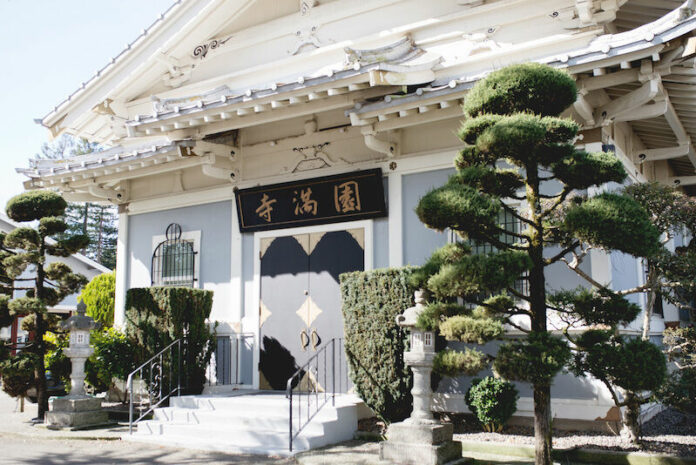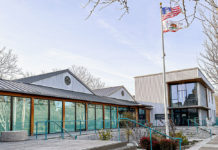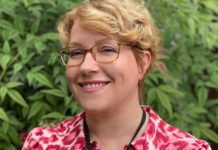
The Enmanji Buddhist Temple of Sebastopol looked into getting a paint job last year when congregants sheltered at home and various temples of the Buddhist Churches of America embarked on fundraisers, according to Diane Ono, president of its board of directors. The cost of repainting is estimated to be so steep that the temple has been working to raise money to cover it.
It’s a historic building to maintain and its most recent paint turns out to be old enough that it still contains lead, which is how a paint company came to estimate the job would run about $60,000, said Ray Yamasaki, board member and a longtime leader at the temple for Jodo Shinshu Buddhism.
The cost is so steep because safe lead removal would require specialized professionals and not volunteers or contractors from the congregation, Ono said. “And the fact that the building was never meant to last this long,” she said.
Ono said the congregation makes the best they can of the aging house of worship, with its now fading, flaking exterior. Or they did, before the church halted in-person services and shifted to videotaped services for the pandemic, some Sundays delivered from the temple’s new supervising minister from the Buddhist Temple of Alameda, she said.
Neither the move online nor the predominantly elderly congregation’s preference for snail mail has stopped the fundraising efforts. The board president said members and the temple’s extended community raised almost half of the $60,000 in mostly mail-in donations since fundraising began around October in 2020.
“We’re very old-school, so there was a solicitation in the newsletter with an envelope to the church, and so they could write a check and send it in the envelope to the church and that’s how most of the donations came in,” Ono said.
The Enmanji Buddhist Temple community raised about $27,000 despite the pandemic squashing plans for the chow mein lunch fundraiser planned for March or their biggest fundraiser of the year, the July teriyaki chicken barbecue and bazaar, she said.
“It feels pretty darn good,” Ono said.
As of Jan. 21, the temple’s capital campaign for exterior renovation has raised $1,140 through a GoFundMe fundraiser put on by board member Cynthia Nakatani early last November.
The board president said another issue has been finding workers to take on the exterior paint restoration that inevitably leads to an encounter with the roof.
“It’s a little treacherous up there,” she said, because the temple and its roof are modeled after temples from the 12th century Kamakura period in Japan and contractors will need to resupport and paint buffeted areas underneath the roof.
The roof itself needs work, too, Ono said, but the temple’s leadership focuses on the broader exterior and other supportive renovations because they have not found anyone willing to try their hand at the unique architecture.
Ono said she did not believe the paint beginning to chip away on the outside walls endangered the groundwater, but keeping workers safe during the lead removal would take expertise.
The Manchurian Railroad Company showcased the temple in the Chicago World’s Fair in 1933, according to the temple’s website. The website said it was donated to the Buddhist Mission of North America and, for the price of its cross-country shipment in pieces, it thus belonged to the Sonoma County Buddhist Temple.
The Enmanji Buddhist Temple was ultimately reassembled in Sebastopol without nails in 1934, the website continued. It has nails now, according to Ono, because it was vandalized in the 1940s.
Someone set the temple on fire during WWII, while most of the local Japanese-American community was incarcerated at Amache Relocation Center in Granada, Colorado, Sonoma West Times & News reported in 2006. Yamasaki said the temple’s leadership chose to preserve some scorch marks on the ceiling as a reminder of the past.
While members have been generous, Ono said it can still feel uncomfortable asking for funds at this time.
“We don’t know what’s going to happen with our economy, so people aren’t as free with their donations. Some people are and some people aren’t. So that’s one of the definite challenges that we have had,” she said.
Thankfully for the Enmanji Buddhist Temple, its membership fees and donations from monthly Shotsuki Hoyo services help keep the lights on and other bills paid, Ono said. The services currently held over video are monthly memorials for loved ones who died that month, regardless of the year, she explained.
“We have enough funds to be able to get us through a little while, but we can’t do that ongoing,” she said, but Ono noted the generosity of many members who sometimes donate for no particular reason, at any given time.







